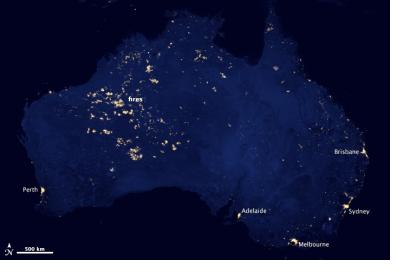A new map of the Earth at night that NASA published two weeks ago showed the footprint of human civilization on the planet, as revealed by the lights we use to brighten the darkness. The map was built by Earth Observatory designers together with colleagues at the National Geophysical Data Center and made possible by a new NASA and the National Oceanic and Atmospheric Administration (NOAA) satellite. But it turns out the map showed something more. Astute readers noticed lights in areas that were thought to be uninhabited. Many of those readers pointed to Western Australia and asked: How can there be so much light there?
The top image above shows the night lights of Australia as observed by the Visible Infrared Imaging Radiometer Suite (VIIRS) on the Suomi NPP satellite in April and October 2012. The composite image includes manmade light sources and the light of wildfires. The data were acquired over nine days in April 2012 and thirteen days in October 2012, and it took the satellite 312 orbits and 2.5 terabytes of data to get a clear shot of every parcel of Earth’s land surface.
The second map is a mosaic showing the burned areas of the landscape (red) from October 11–24, 2012, combined with urban areas (black). The data were collected by the Moderate Resolution Imaging Spectroradiometer (MODIS) instruments on NASA’s Terra and Aqua satellites. In effect, the map shows where fires burned that month. Though many rural areas of interior Australia are dry and relatively barren by some standards, there is still enough vegetation to burn, as you can see by clicking on this view from the International Space Station and others from the MODIS instruments.
The extent of the lighting in the Outback and bush country is a function of composite imaging. Fires and other lights that were detected on one day were integrated into the composite, multi-day picture despite being temporary phenomena. Because different lands burned at different times that the satellite passed over, the cumulative result is the appearance of a massive blaze. But while the cities are fixed, the fires were temporary, moveable features. The night lights data set is a scientific work in progress, and the maps will be refined and improved over time.

